Boosting Your Home’s Worth: Does Adding a Deck Pay Off in New York?
Picture this: string lights twinkling overhead, burgers sizzling on the grill, a soft breeze coming off the lake, while friends gather around your outdoor table with laughter in the air. Or maybe it’s just you, a cup of coffee, and a peaceful sunrise view from your favorite lounge chair.
If you’re thinking of adding a deck to your New York home, keep this in mind: buyers aren’t just looking for square footage—they’re looking for a feeling. That morning cup of coffee, the evening barbecue with friends, the quiet sunset views—these are the moments that make a house feel like home. And when your deck is staged to reflect that lifestyle, it can leave a powerful impression.

It’s more than just a lifestyle upgrade—it could also boost your home’s resale value. Especially in places like the Finger Lakes, where outdoor living is a big part of everyday life, a well-built deck can make a lasting impression on potential buyers.
At Keystone Custom Decks, we specialize in designing and building high-end outdoor living spaces that blend beauty with function. If you're exploring options, start by browsing our custom deck designs and features for inspiration.
And here’s the good news:
A deck can boost your home’s resale value. But how much? And what factors actually move the needle?
Let’s break down what you need to know.
Average ROI: What the Numbers Say
First things first—what’s the return on investment (ROI)?
Adding a deck is one of the most valuable home improvement projects in terms of increasing a home’s resale value. According to Remodeling Magazine’s Cost vs. Value Report (2024), the national average ROI for a wood deck addition is around 50-60%, while composite decks recoup about 45-55% of their cost at resale. That means if you spend $20,000 on a deck, you might recoup over $10,000 at resale. Not bad—especially considering you also get years of enjoyment in the meantime.
But what about New York?
In New York—particularly in scenic regions like the Finger Lakes, Hudson Valley, or the Adirondacks—decks are often more than a luxury—they’re expected. Buyers looking to enjoy summers outside want a space that’s already built. That means a well-designed deck could have a stronger emotional value, pushing up both perceived and actual resale value. This can help a home sell faster and for more money, even if it doesn't boost the appraisal dollar-for-dollar.
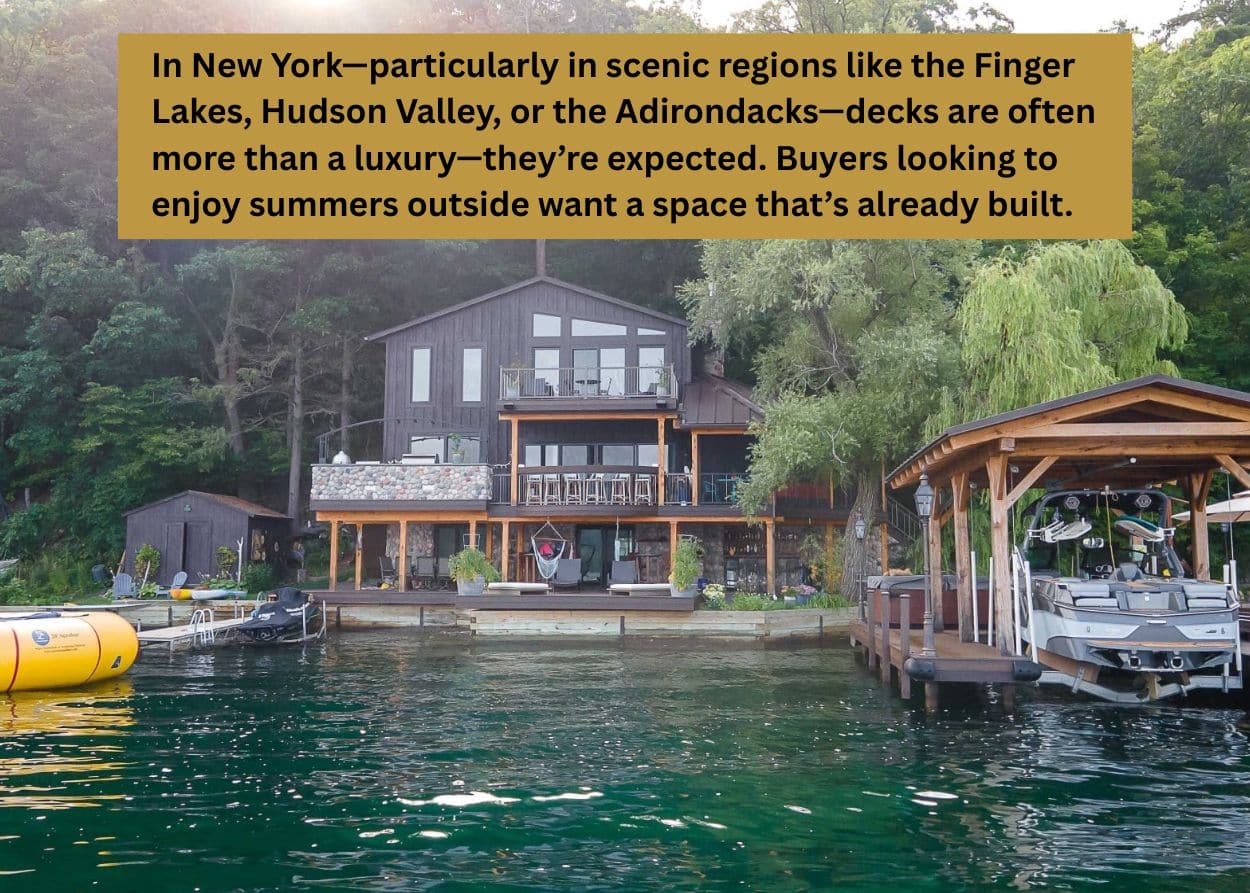
Bottom line? A deck might not return 100% of the cost—but it does return real value in both dollars and desirability.
Design Matters: Size, Layout & Features
A deck isn’t just a slab of boards. It’s an extension of your home—and buyers notice when it's thoughtfully designed.
The size of your deck matters, but bigger isn’t always better. What counts is how well the deck fits the yard, flows seamlessly from the house, and supports how people live. A modest deck that includes built-in seating, lighting, and a covered section can feel far more inviting than a sprawling, empty platform.
Layout and features play a significant role. Some high-value features to consider:
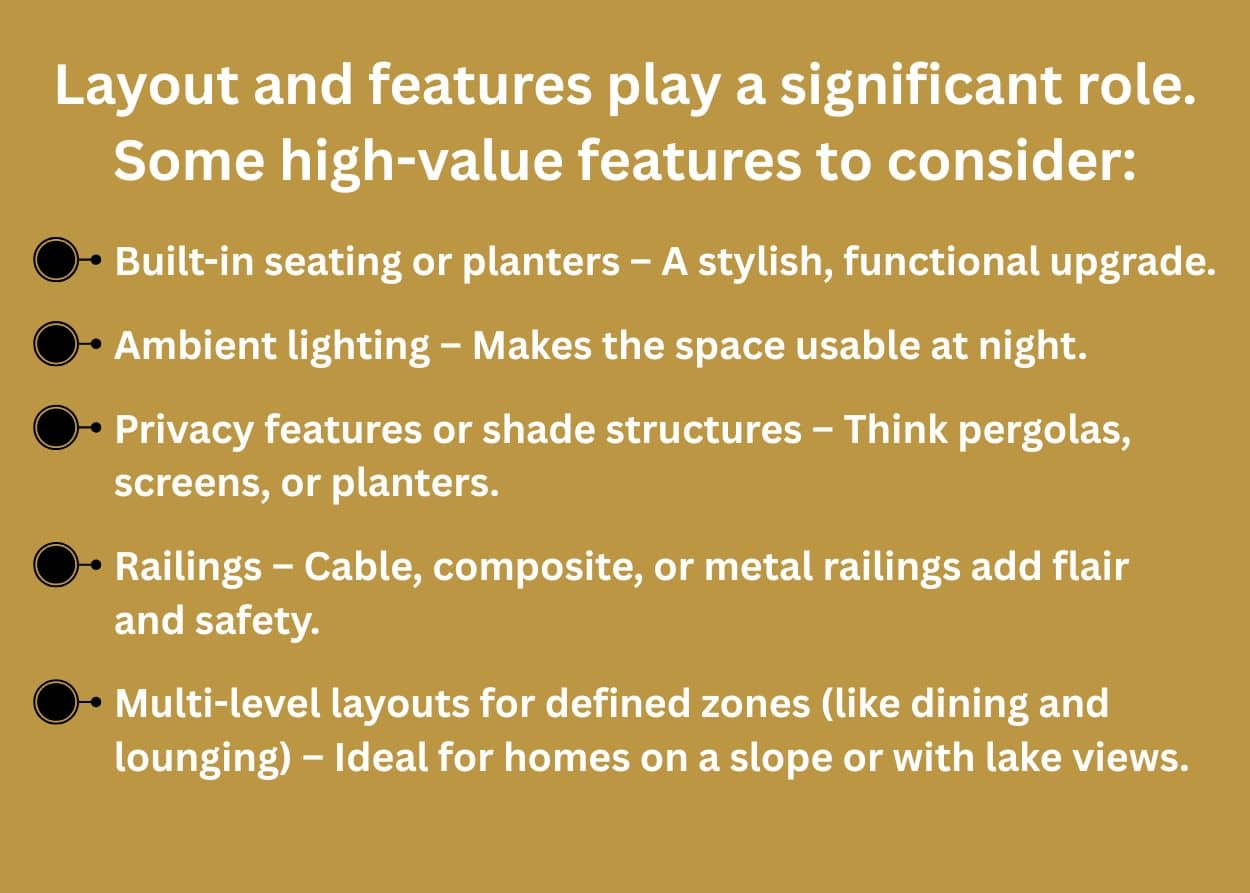
- Built-in seating or planters – A stylish, functional upgrade.
- Ambient lighting – Makes the space usable at night.
- Privacy features or shade structures – Think pergolas, screens, or planters.
- Railings – Cable, composite, or metal railings add flair and safety.
- Multi-level layouts for defined zones (like dining and lounging) – Ideal for homes on a slope or with lake views.
The goal? Make the deck feel like a natural extension of your home—not an afterthought.
Want inspiration? Check out these deck design ideas from Trex to see how modern layouts combine function with style.
In New York, where outdoor entertaining is popular in spring through fall, decks that create seamless indoor-outdoor transitions often perform best. Thoughtful touches—like a grilling nook or privacy screen—can tip the scale in your favor when it’s time to sell.
Composite vs. Wood: Material Choice Impacts Resale
When it comes to deck value, materials matter—a lot.
Not only do they impact your upfront costs and long-term maintenance, but they also influence how buyers perceive the space. Some materials signal luxury and low upkeep, while others appeal to buyers who value classic charm or affordability.
Let’s compare three of the most popular decking materials—composite, pressure-treated wood, and cedar—to see how each one holds up in terms of resale value, aesthetics, and homeowner expectations.
Composite decking (like Trex or TimberTech):
- Higher upfront cost
- Lower Maintenance
- 25+ year lifespan
- Trendy, modern look
- Strong long-term appeal to buyers
- Lower cost
- Needs regular sealing/staining
- Can warp or splinter over time
- Still widely used due to affordability
- Naturally rot-resistant
- More expensive than pressure-treated
- Adds a warm, natural feel
Bottom line? Composite decking tends to attract higher-end buyers in areas like the Finger Lakes, where outdoor living is a big part of the lifestyle.
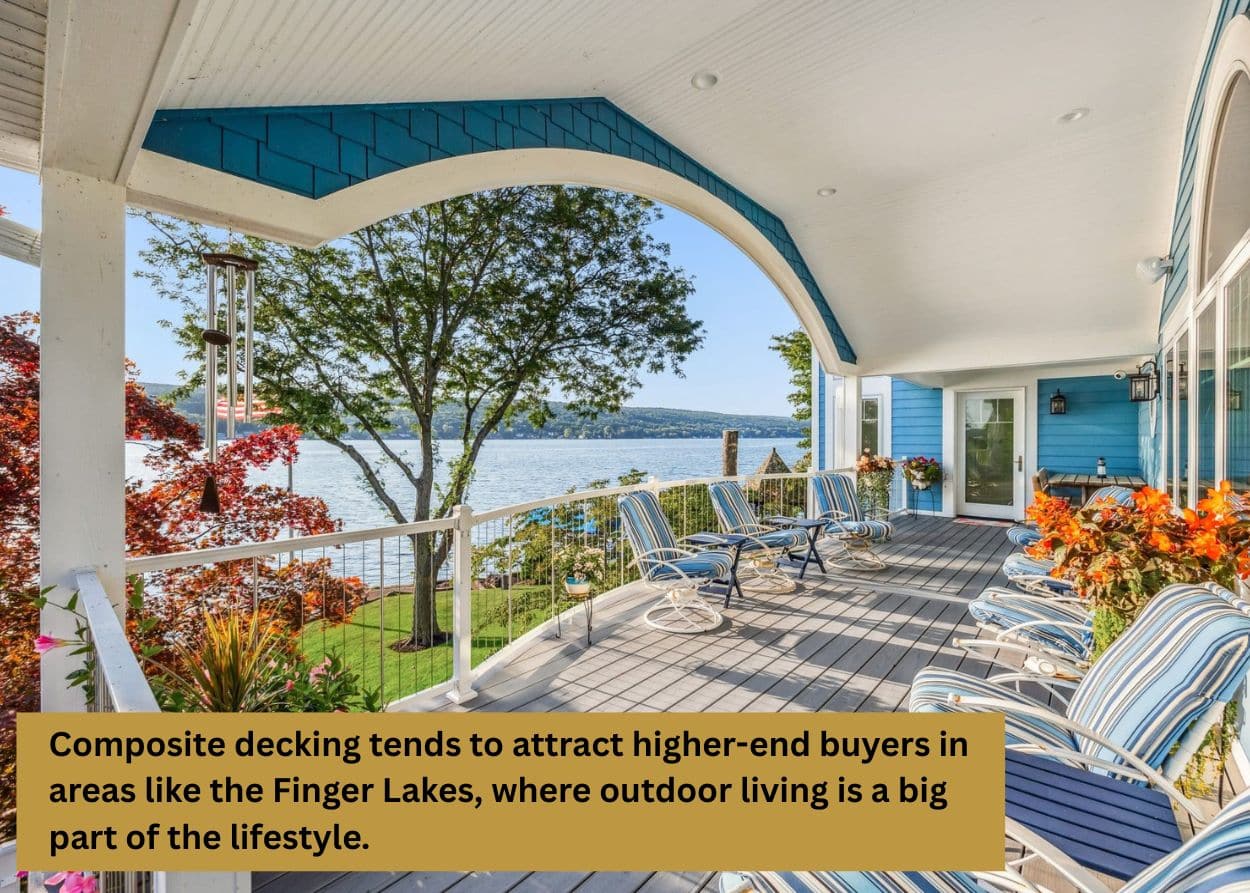
What Makes New York Unique?
You can’t ignore regional factors.
Here’s how building in New York—and especially Upstate NY—affects deck value:
- Climate: Snow, rain, and freeze-thaw cycles mean durable materials are key.
- Permits: Many towns (including in the Finger Lakes) require permits for any structure over 30" high. A reputable contractor will handle this for you.
- Neighborhood standards: If most homes in your area have a deck, not having one can hurt resale appeal.
And let’s not forget this: New York summers are stunning. Buyers want a way to enjoy them without having to leave home.
Cost vs. Value: What’s Worth It?
Not every deck upgrade will boost your home’s value equally. The key is to balance your budget with long-term benefits—and that starts with thoughtful planning.
Here are a few things to keep in mind:
- High-end features like outdoor kitchens, fireplaces, and covered areas are beautiful—but pricey. Use them strategically.
- Match the investment to your neighborhood. A luxury $80,000 deck may not yield a return in a modest home market. On the other hand, a modestly priced composite deck with thoughtful design can offer strong resale appeal and lower maintenance over time.
- Low-maintenance materials = long-term savings. Composite decking, while more expensive upfront, often requires less maintenance than wood, saving you time and money in the long run. That long-term savings adds value for future buyers.
- Classic designs age better. Avoid overly trendy layouts or finishes that could turn off buyers in 5–10 years.
- Functional spaces win. Built-in seating, shade features, or zones for grilling and relaxing appeal to almost every buyer.
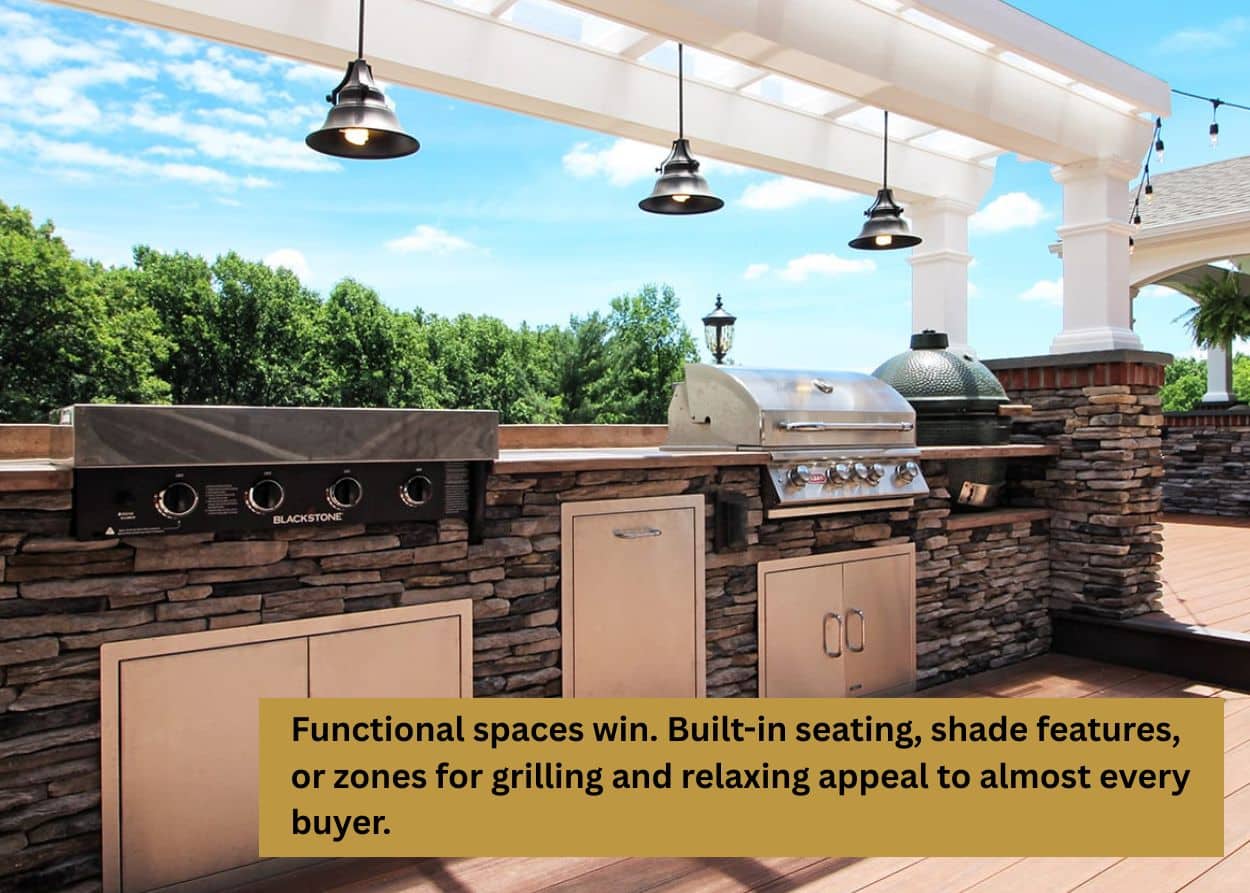
To get a better idea of how features and materials impact project costs, HomeAdvisor’s deck cost guide is a great starting point.
And remember: it’s not just about resale. It’s about enjoying your space now and later.
In short? Wise choices now lead to better value later—both for you and future buyers.
How to Stage Your Deck for Maximum Impact
Already have a deck? Want it to wow potential buyers?
Staging isn’t just for interiors. A well-prepped deck can make your outdoor space feel like an extension of your living room—especially during spring and summer showings.
Try these simple (but effective) staging tips that make a big difference:
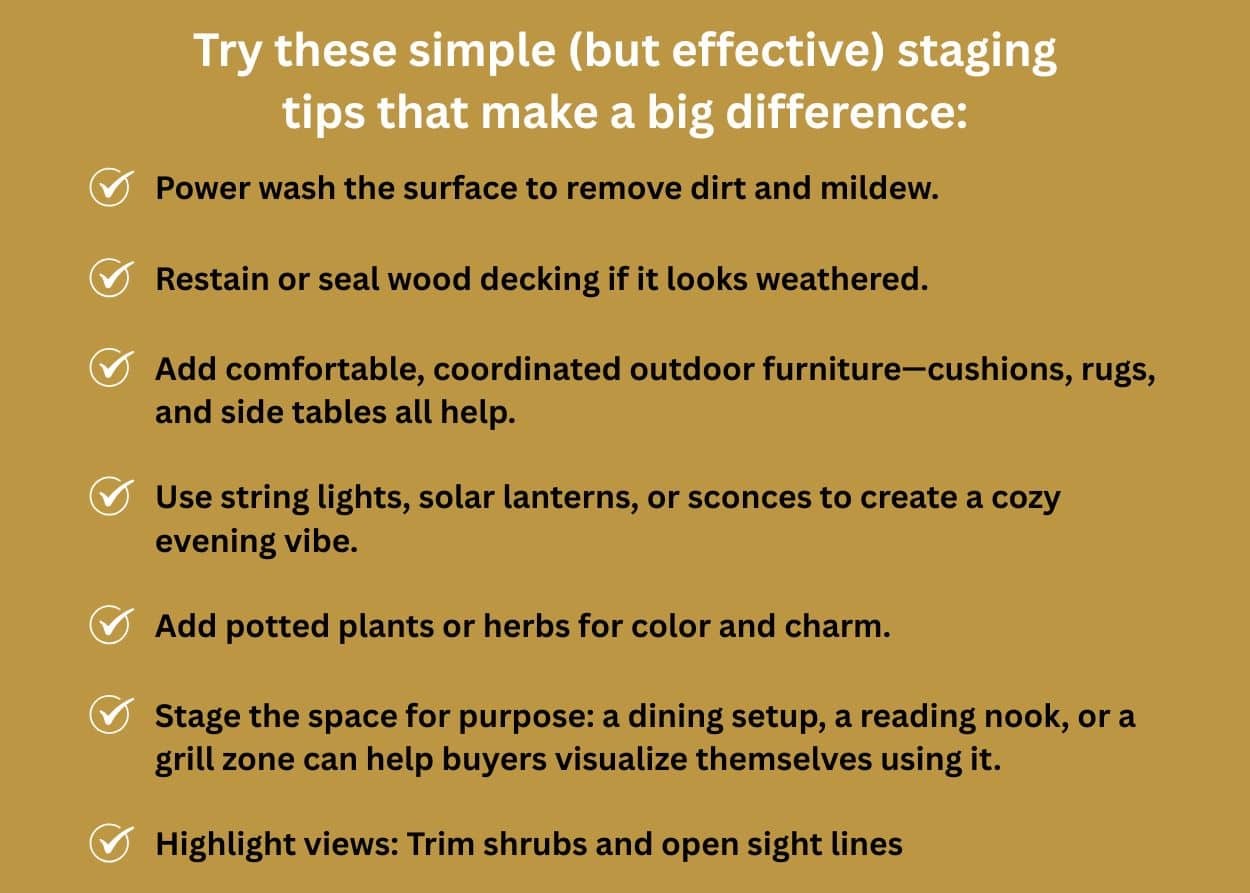
- Power wash the surface to remove dirt and mildew.
- Restain or seal wood decking if it looks weathered.
- Add comfortable, coordinated outdoor furniture—cushions, rugs, and side tables all help.
- Use string lights, solar lanterns, or sconces to create a cozy evening vibe.
- Add potted plants or herbs for color and charm.
- Stage the space for purpose: a dining setup, a reading nook, or a grill zone can help buyers visualize themselves using it.
- Highlight views: Trim shrubs and open sight lines
For even more ideas, check out these deck staging tips from Mark Spain Real Estate.
Bottom line? A clean, styled deck helps buyers see it not just as a bonus—but as a place to live, relax, and make memories. Buyers need to see themselves relaxing, entertaining, and living life on your deck.
Final Thoughts: So, Does a Deck Add Value to a Home in New York?
Yes. But only if it’s done right.
In New York’s beautiful-but-rugged climate, you’ll get the best ROI by choosing high-quality materials, thoughtful design, and professional installation.
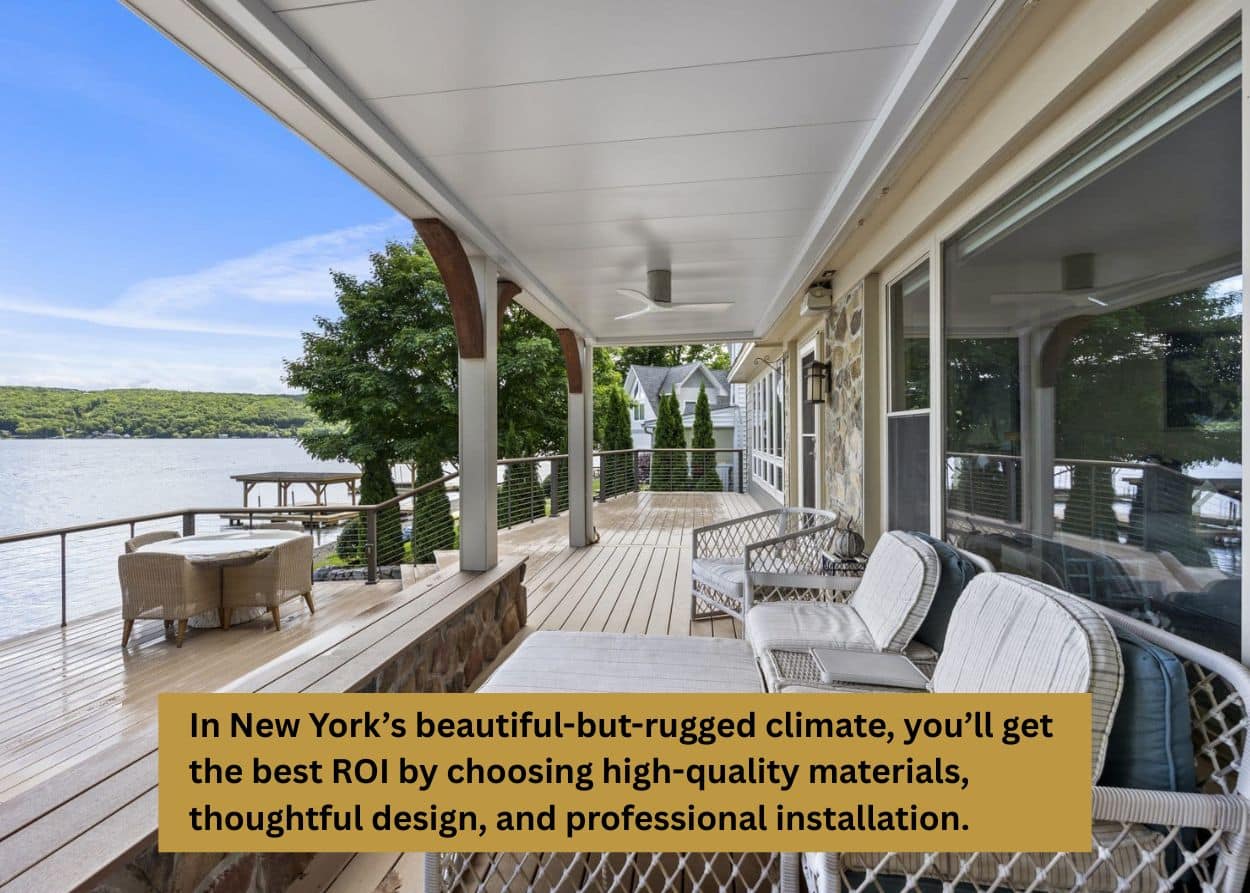
At Keystone Custom Decks, we build stunning, custom outdoor living spaces tailored to the Finger Lakes lifestyle. From composite decking to complete outdoor kitchens, we help homeowners create value, not just for resale but for everyday life.
Want to start planning your dream deck?
Schedule a complimentary consultation, and let’s build something beautiful together.







